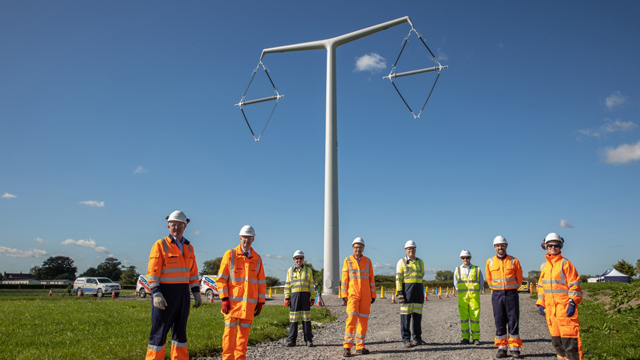
Construction of world's first T-pylon completed
Last week saw an exciting moment with our construction of the world’s first T-pylon in Somerset; part of our Hinkley Connection project, connecting six million homes and businesses to low-carbon energy. Here Zac Richardson, Director of New Infrastructure, tells us about his recent visit to the site and shares more about how we’re innovating for a net zero transmission system.
It was fantastic to visit the site of the first T-pylon this week – the first new design for a pylon in nearly 100 years.
Seeing the pylons first-hand really brought to life the different look. It’s a great example of innovative new approaches in our role of managing the transmission network.

Innovating for net zero while caring for the natural environment
The transition to net zero and rapid changes to the energy system in Great Britain means those new approaches are needed swiftly.
Our transmission system will form the backbone of net zero, delivering increasing amounts of renewable energy from the North Sea and East Coast, and supporting a nationwide rollout of charging points to support the transition to electric vehicles. It stretches across different communities and landscapes throughout Great Britain, so it’s only right we play our part in protecting and enhancing the natural environment.
T-pylons form part of a suite of technologies and approaches to complement the external landscapes, including alternative lattice pylon designs and different types of underground and subsea cable systems – with each approach chosen where it’s operationally possible and cost efficient for electricity consumers.
But innovation isn't just about visually updating our infrastructure, we're also developing new approaches for planning and designing the network. To support the delivery of the prime minister’s commitment of 40GW of offshore wind generation, major onshore development and reinforcement of the electricity network will be necessary. We are working in partnership with government, industry and communities to ensure this necessary infrastructure is delivered in a way that minimises the impact.
Making the most of our existing network
We are also finding new ways to make the most of our existing network. As more renewable generation comes onto the network, power flows change and our circuits can become unequally loaded; meaning some reach maximum capacity while others are below their limits.
Our SmartWires project is using new technology at substations in the North of England to unlock extra capacity, allowing greater volumes of renewable power to be efficiently transferred to customers. And at our innovation centre on Deeside, we are working with SSE to trial using excess heat from power grid transformers to heat local homes and business.
The energy sector is changing rapidly and so is the transmission system, and T-pylons are a great example.
The energy sector is changing rapidly and so is the transmission system, and T-pylons are a great example. Over the next decade we will continue to adapt to these changes in faster and smarter ways, innovating for more sustainable energy solutions and playing our part in delivering on our shared net zero commitments.
As the world’s first operational T-pylons are constructed along the Hinkley Connection route, pupils from 20 local schools are preparing time capsules with 2021-related memorabilia to be hidden inside the structures; revealing what our lives were like 70 years from now.
Find out more about T-pylons and the time capsules
Watch related video
Take a look at our video, where Project Director James Goode talks about the T-pylon’s construction.


